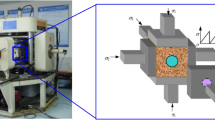Abstract
Tunnels passing beneath deep rock cover (overburden) are subject to instabilities caused by induced rock stresses. In a relatively unjointed massive rock mass the instability is associated with rock spalling/rock bursting, while if the rock mass is weak, schistose, sheared and deformed, squeezing is more likely. This paper reports a study which reviews stress-induced instability along the Parbati II headrace tunnel, evaluates the rock mechanical properties directly linked to the stress-induced instabilities and back-calculates the magnitude of the in situ stress state using finite element numerical modeling. An attempt is made to evaluate the magnitude of the tectonic horizontal stress component and to estimate the rock burst depth-impact. It is emphasized that more cases of tunnel damage should be studied to verify the applicability of the proposed equations and to establish the approximate range of the horizontal tectonic stress component along the Himalayan chain.
Résumé
Les tunnels sous forte couverture rocheuse sont sujets à des instabilités résultant des contraintes induites à grande profondeur. Dans un massif rocheux de roche dure et relativement peu fracturée, l’instabilité se traduit par des écaillages et de la décompression violente. Dans un massif rocheux de roche tendre, schisteuse ou en zones de cisaillement, l’instabilité se traduit par de la forte convergence. L’article présente une revue des instabilités résultant des contraintes induites observées le long de la galerie d’amenée de Parbati II. Il évalue les propriétés mécaniques directement liées à ces instabilités et, par rétro-analyse, calcule l’état de contrainte in situ à partir d’une simulation numérique par éléments finis. Une tentative est faite pour évaluer l’intensité de la composante horizontale des contraintes d’origine tectonique et pour estimer la profondeur critique d’apparition des phénomènes de décompression violente. Il est souligné que davantage de dommages en tunnel devraient être étudiés pour vérifier l’applicabilité des équations proposées et pour établir les plages de variation de la composante horizontale des contraintes d’origine tectonique le long de la chaîne himalayenne.








Similar content being viewed by others
References
Hoek E Carranza-Torres C, Corkum B (2002) Proceeding of the NARMSTAC Conference, Toronto, vol 1, pp 267–273
Hudson JA, Harrison JP (1997) Engineering rock mechanics an introduction to the principle. Pergamon Press, New York
Martin CD, Christiansson R (2009) Estimating the potential for spalling around a deep nuclear waste repository in crystalline rock. Int J Rock Mech Min Sci 46:219–228
Martin CD, Kaiser PK, McCreath DR (1999) Hoek–Brown parameters for predicting the depth of brittle failure around tunnels. Can Geotech J 36(1):136–151
NHPC (2000) Geological data—Parbati II hydroelectric project stage II, Himachal, India. Contract agreement for civil and hydro-mechanical works for headrace tunnel and associated works (PB-2), vol 8. National Hydroelectric Corporation Ltd. (NHPC), India
Panthi KK (2003) Field visit and laboratory test report on TBM section of headrace tunnel, Parbati II Hydroelectric Project, Himachal. Norwegian University of Science and Technology (NTNU), Norway
Panthi KK (2006a) Analysis of engineering geological uncertainties related to tunneling in Himalayan rock mass conditions. Doctoral theses at NTNU 2006:41, Norwegian University of Science and Technology (NTNU), Norway ISBN 82-471-7826-5
Panthi KK (2006b) Evaluation and analysis of geological adversity for headrace tunnel between Adit 1 and Adit 2. Parbati II Hydroelectric Project, Himachal (evaluation report)
Panthi KK (2009) Appropriateness of open TBM in the Himalayan rock mass conditions—a case study. Proceedings of the ISRM Regional Symposium EUROCK 2009, Cavtat Croatia, 28–31 October 2009, pp 815–820
Panthi KK (2011) Assessment on stress induced instability in a tunnel project of the Himalaya. Proceedings of the 12th ISRM International Congress on Rock Mechanics. Harmonizing Rock Engineering and the Environment, Beijing, October 2011, pp 1777–1782
Panthi KK (2012) A probabilistic approach in assessing tunnel squeezing—a discussion based on tunnel projects from Nepal Himalaya. Proceedings of the 46th US Rock Mechanics/Geomechanics Symposium to be held in Chicago, 24–27 June 2012
Panthi KK, Nilsen B (2007) Uncertainty analysis of tunnel squeezing for two tunnel cases from Nepal Himalaya. Int J Rock Mech Min Sci 44:67–76
Selmer-Olsen R (1965) Stability of tunnels in valley sides (in Norwegian). IVA-meddelande. vol 142, Stockholm, p 77–83
World Stress Map (2008) World stress map based on the database release 2008. http://www-wsm.physik.uni-karlsruhe.de/pub/stress_data/stress_data_frame.html
Author information
Authors and Affiliations
Corresponding author
Rights and permissions
About this article
Cite this article
Panthi, K.K. Evaluation of rock bursting phenomena in a tunnel in the Himalayas. Bull Eng Geol Environ 71, 761–769 (2012). https://doi.org/10.1007/s10064-012-0444-5
Received:
Accepted:
Published:
Issue Date:
DOI: https://doi.org/10.1007/s10064-012-0444-5




